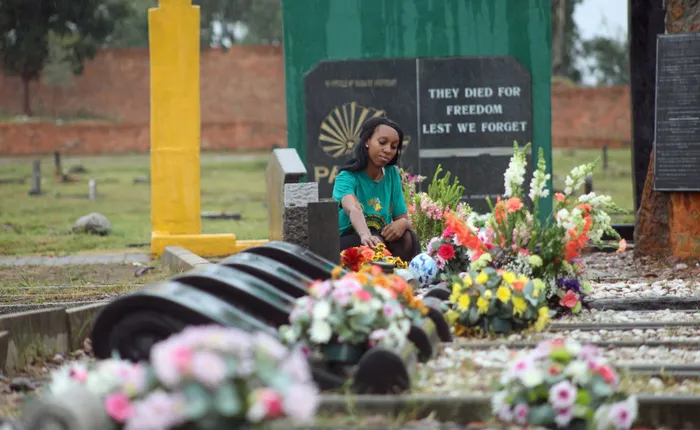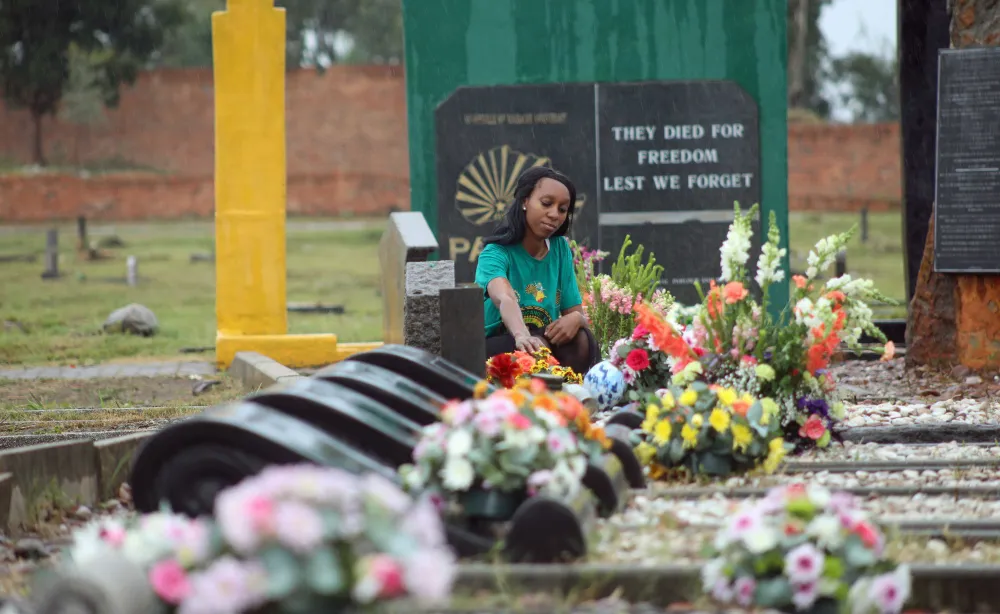‘Human rights for only some are human rights for none’

Sharpeville, March 21, 2022. Remaining family members of the Sharpeville massacre visits the grave site 62 years to the date after the shooting took place. Ayanda Mnguni is following in the steps of her great grandfather Jan Mnguni. While ‘today is a far cry from the days of influx control and the hated pass laws’ in which South Africans all enjoy the right to freedom of movement, it still has a far way to go to ensure that all citizens are equal, the writer says. – Picture: Timothy Bernard / African News Agency (ANA)
People lie dead in the streets of Sharpeville after police opened fire on them during a peaceful protest against the Dompas, a hated document black people were forced to carry around in White South Africa under apartheid. March 21, 1960, was a human rights bloodbath. The protest, spearheaded by the PAC, ended in tragedy as the South African Police killed 69 people and injured a further 180, the writer says. – Picture: ANA files
By Kim Heller
The President’s Monday morning letter to the nation focussed on Human Rights Day which South Africans observe this week. Cyril Ramaphosa wrote, “As we commemorate the tragic events that took place in Sharpeville in 1960, and recommit ourselves to the cause of human freedom, we stand firm in our position that human rights for only some are human rights for none”.
Ramaphosa’s words echo the timeless chorale of working-class accord – “An injury to one is an injury to all”. In a world teeming with justice, equity and fairness, human rights would be equally dispersed among people, without privilege or prejudice. Such a nirvana would be a meadowland of well-being for all, rather than a privileged prairie for a select few. But in the battlefield of the real world the interests and human rights of ordinary people are too often stifled in the quests and conquests for country and world power.
March 21, 1960, was a human rights bloodbath. On that day in Sharpeville thousands of black South Africans demonstrated against the indignity and inhumanity of the racist and discriminatory pass laws which stripped their right to move around freely in very their own land. The protest, spearheaded by the PAC, ended in tragedy as the South African Police killed sixty-nine people and injured a further 180.

The Sharpeville massacre is not only a poignant permanent marker of human rights abuses in the apartheid era. It also provides a historical signpost in the South African journey from an inhumane and injurious past towards a flourishing future. A future where human rights will be in abundance across all aspects of society, and will be the preserve of all, irrespective of race, gender, and identity.
“The South Africa of today is a vastly different place to what it was thirty years ago. The fundamental freedoms that were denied to so many, including the heroes who lost their lives at Sharpeville, are enjoyed by South Africans today,” the President said. This during his address this week at the National Conference on 30 Years of Human Rights in South Africa. The three-day conference attended by top ANC leaders, Ministers, and key stakeholders, was intended as an introspective reflection on the human rights journey in democratic South Africa.
Ramaphosa said, “we can be justifiably proud of how far we have come in advancing our constitutional, human rights-based order over the past 30 years. Today is a far cry from the days of influx control and the hated pass laws, in South Africa today every citizen enjoys the right to free movement”.
Thirty years into democracy, considerable strides have been made on human rights. The ANC government has done much to extend citizen’s rights to basic services and provisions, including health care, water, and electricity. Today close to nine out of ten people in South Africa have access to clean drinking water, compared to just six out of ten in 1994. Since 1994, over 3.2 million free houses have been built. In 1999, the introduction of the national minimum wage increased the wages of over six million workers. The provision of free schooling, early childhood development and widespread school nutrition programmes are among many commendable achievements in the restoration of human rights and dignity.
The list of human rights achievements in the past 30 years is long but hardly complete.
Today the achievements made in the past 30 years on the human rights front are somewhat overshadowed by the dire state of the current economy and widespread societal deterioration. There were 11.7 million unemployed people in South Africa at the end of 2023. Today with unemployment over 30 percent, a 60 percent youth unemployment rate, deep levels of poverty and an incessant inscription of inequality, many South Africans will have little to celebrate on Human Rights Day. Especially in a country which despite 30 years of democracy, has failed to address land justice and land return. To celebrate Human Rights Day while remaining landless is a sad party indeed.
Today, the state and welfare of human rights in South Africa remains ruptured by the fault lines of a long history of injustice and inequality. While the notion of human rights for all is enshrined in the Constitution, there is an undeniable hierarchy of human rights in contemporary South Africa along racial and geography.
In his book, Sharpeville: An Apartheid Massacre and Its Consequences, political scientist and author Dr Tom Lodge wrote “For many of the people who lived through the Sharpeville massacre, their daily existence will always be configured by a history that has never turned course.”
In 2010, Lodge wrote, “In appearance Sharpeville would still be quite recognisable to anyone returning after a fifty-year absence. Rows of mainly ochre and grey four-room dwellings still line most of the roads and lanes, the standard “matchbox” houses constructed in hundreds of thousands across South Africa in the 1950s, utilitarian brick cabins with asbestos roofs and outhouse toilets. Some have been subjected to improvements: concrete tiles on the roofs, painted and plastered walls, burglar bars and front stoeps and on a few stands residents have built over their plots, walling their gardens, and replacing the matchboxes with suburban double storeys.”
Lodge continues, “Television satellites, power lines, and cell-phone masts reflect key changes in the way that people live their lives since the 1960s but there are not many signs of post democratic affluence. The heavy industries that were once the economic staple of this region are now in decline and local unemployment levels are somewhat higher than the already steep national average. What might have been Sharpeville’s new middle class now lives in Vereeniging or even further afield in the leafy neighbourhoods by the Vaal River.”
Today’s Sharpeville should be a wholly different place from the Sharpeville of 1960. But it is not. It stands today as a symbolic reminder of the work that is still required in terms of restoring the human rights, dignity, and prosperity landscape of black South Africans. That the poor township Sharpeville of today is a starkly different world from the rich suburb of Sandton is a piercing reminder of resident inequalities in democratic South Africa not only on the economic but human rights spectrum. The racist apartheid ‘Dompas’ may have been lifted. But today the horribly racially skewed and unaddressed unequal social, economic, geographic, and power relations conspire and serve as an “invisible” Dompas for it restricts the economic and educational mobility and agility of black South Africans. It also restricts the even distribution of human rights.
This week Ramaphosa acknowledged that the after-effects of apartheid persist in many spheres of the economy and impact on developmental outcomes, service delivery and economic inclusion.
Gender based violence is a serious human rights issue in South Africa. At this week’s conference Dr Geraldine Fraser-Moleketi spoke of how the scourge of gender-based violence and femicide directly infringes on women’s right to freedom and security of person. To abate and address the scourge of gender-based violence will require a full circle solution, from fostering the right family and societal values and behaviour to Constitutional and legal protection.
If Ramaphosa’s words about the government’s commitment to human rights for all are to be taken seriously then these should extend to both foreign nationals in South Africa and foreign nations that contravene human rights. Human Rights Watch (HRW) recently expressed concern about xenophobia ahead of the upcoming general election. HRW reported that “the silence and inaction of the government in the face of anti-immigrant hate speech, including by public officials, blocking foreign nationals from accessing healthcare, and raiding and closing businesses belonging to foreign nationals, is a blight on South Africa’s constitutional and international human rights obligations.”
While the South African stance on the Gaza-Israel conflict, and the government’s support of human rights in Palestine has and should be applauded, its relative inactivity on human rights abuses on the Continent has drawn some sharp criticism. If President Ramaphosa and the ANC government are “committed to global peace and will fight all forms of oppression” then the deeds of the President and government must match these valiant words and the South African government must assist more positively and more actively in bringing an end to human rights violations on the Continent.
During his address at this week’s Human Rights Conference, the President spoke of the adoption of the Constitution with its Bill of Rights by the Constitutional Assembly on May 8, 1996, as a great moment in our struggle to achieve a free and equal society and as the ‘birth certificate of our nation’. Democratic South Africa is no longer a toddler. At thirty years old, it should be a responsible adult poised for prosperity.
Ending the culture of human rights violations is not the responsibility of government alone. It will require the participation of all citizens and institutions. Institutions such as schools, universities, and colleges need to incorporate human rights issue in the curriculum as a way of inculcating a human rights consciousness.
Chapter 9 institutions, which have been mandated by the Constitution to protect human rights, and which have abrogated their responsibility to become another part of the armoury for political battles must be called out and severely reprimanded. The media can play an enormously positive nation building role in hotwiring social consciousness and active citizenry around issues of human rights and dignity. Instilling a society wide culture of human rights for all, not just a select few, is the combined work of a nation fully invested in its future.
Kim Heller is a political analyst and author of ‘No White Lies: Black Politics and White Power in South Africa’.
This article was written exclusively for The African. To republish, see terms and conditions.